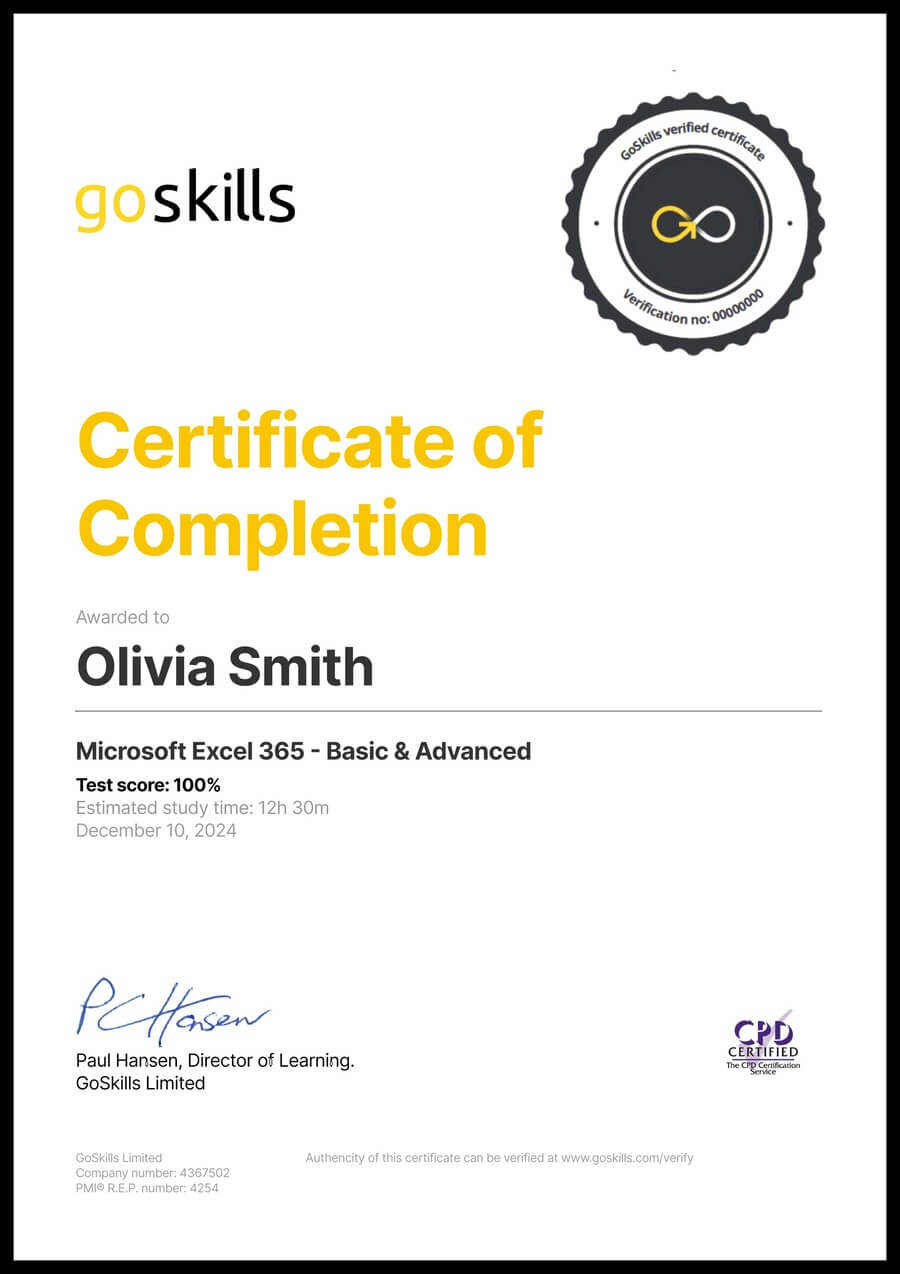Microsoft Excel Training | Excel Certification Course
Microsoft Excel 2019 - Basic & Advanced
Skills you’ll gain
Master Excel with our #1 online Excel training for business
Looking for Microsoft Excel training to improve your skills and productivity? GoSkills Basic and Advanced online Excel courses can quickly improve anyone’s productivity level — whether you’re a complete novice or already an Excel expert — all in a matter of hours!
Online Excel classes to help unlock your potential
By the end of the course, you’ll be equipped with the real-world Excel knowledge needed to tackle everything from reports and charts to complex data analysis and project management.
Not to mention, earn major bragging rights after securing a highly sought-after Excel certification.
By the end of this beginner-friendly course, you’ll be able to:
- Effortlessly navigate the Excel interface.
- Boost Excel productivity with foolproof formulas and shortcuts.
- Get data ready for analysis with organized and filtered data.
- Master math, statistical, logic, and text functions to manipulate data.
- Sort and filter data to quickly find important information.
- Use charts and graphs to present clear insights.
- Create and format Pivot Tables to summarize large data sets.
- Automate repetitive Excel tasks.
- Learn newly released formulas and features like XLOOKUP and Dynamic Arrays.
- Use data validation to restrict data entry and reduce input errors.
- Customize page setup options for printing.
Over 100,000 people have learned practical, actionable Excel skills for business from our self-paced online classes to help them work smarter every single day.
Ready to add value, save time, and boost your productivity? Start learning with our certified Excel for business course today!
Syllabus
Download syllabus-
1
Logic Functions Learn to build standalone logical IF functions, and make them more complex by nesting AND and OR within them. 5m
-
2
Text Functions Learn to break apart text with the LEFT, RIGHT, MID, FIND and SEARCH functions, and to combine text with the & character. 6m
-
3
Understanding Dates Understand how dates work in Excel using the TODAY, YEAR, MONTH, DAY and DATE functions. 3m
-
4
Understanding Time Understand how time works in Excel, and how to change from whole numbers into time increments and back again. 4m
-
5
Cell Referencing Learn about working with absolute and relative cell referencing, and techniques for copying formulas. 5m
-
6
Math Functions Learn basic math functions including SUM, ROUND and SUBTOTAL. 6m
-
7
Basic Statistics Learn basic statistical functions including COUNT, COUNTA, AVERAGE, MAX, MIN, MEDIAN and MODE. 4m
-
8
Formula Anatomy Understanding Excel Formula Anatomy 6m
-
9
Function Anatomy Use to understand the anatomy of Excel functions, and what their components mean. 5m
-
1
Formula Auditing Learn to work with formula auditing tools including tracing precedent and dependent cells and formula evaluation. 5m
-
2
Conditional Math Learn to use SUMIF and COUNTIF to add cells only when certain conditions are met. 5m
-
3
External Links Learn about creating and updating external links, and about the potential dangers of external links in Excel. 5m
-
4
Temporal Functions Learn to work with the EOMONTH and EDATE functions that easily shift dates from one month or year to another. 4m
-
5
VLOOKUP with Approximate Match Learn to use VLOOKUP to find an approximate match and return it or the corresponding value from another column. 4m
-
6
VLOOKUP with Exact Match Learn to use VLOOKUP to find an exact match and return it or the corresponding value from another column. 5m
-
7
Other Lookup Methods Learn to work with INDEX, MATCH and HLOOKUP, as alternatives to the VLOOKUP function. 5m
-
8
Introduction to XLOOKUP An introduction to the new XLOOKUP function in Microsoft 365. Bye, bye VLOOKUP, HLOOKUP and INDEX/MATCH! Note: this lesson uses Excel Tables, which are introduced in the next section. 7m
-
1
Sorting Learn to sort data in Excel by a single column or by multiple columns. 4m
-
2
Filtering Learn to filter Excel data for specific words, dates, and apply multiple filters to a single data table. 5m
-
3
Naming Ranges Learn about creating named ranges, and the benefits of doing so. 4m
-
4
Excel Tables Learn about creating Excel tables, and their advantages. 5m
-
5
Recording Macros Learn to record basic Excel macros to automate your actions (instead of doing them manually). 5m
-
1
Creating PivotTables Learn to create and modify basic PivotTables (for quickly summarizing and highlighting data). 4m
-
2
Formatting PivotTables Learn to control formatting and other options in PivotTables. 5m
-
3
Calculated Fields in PivotTables Learn to create and modify basic calculated fields for PivotTables. 4m
-
4
What-If Analysis Learn to perform what-if analysis in Excel using the Scenario Manager and Goal-Seek. 5m
-
1
Contiguous Data Power Query is the best tool for consolidating your data so it's vertically contiguous (without blank rows or other garbage) – for Tables, PivotTables and Charts. 4m
-
2
Unpivoting Data If you work with PivotTables a lot, you know that they put information out the way users want to read it, but you can't use it to drive another PivotTable. So what if there was an easy way to unpivot the data? There is, and it's called Power Query! 5m
-
3
Importing Data from a Text File Importing data from a text file into an Excel table using Power Query. 5m
-
4
Appending Tables Appending tables is the process of stacking them vertically to create long tables that can be used to feed business intelligence solutions and PivotTables. 5m
-
1
Cell Formatting Learn to work with the Format Cells dialog to apply text rotation and borders, and to center data across multiple cells. 4m
-
2
Outlining Learn about adding and working with Excel’s outlining tools to quickly hide irrelevant sections of your worksheet. 5m
-
3
Custom Number Formats Learn to build your own custom number formats to display dates, values and variances how you want to see them. 6m
-
4
Conditional Formats with Built-In Rules Learn to create top/bottom and highlight cell rules, as well as to apply icon sets and data bars. 5m
-
5
Conditional Formats with Custom Rules Learn to create custom conditional formatting rules based on formulas. 5m
-
6
Building Column Charts Learn how to create an effective column chart by reducing ink and 'noise' that distract from the main messages. 3m
-
7
Building Pie Charts Learn how to build an effective pie chart, and when you should and shouldn’t use them. 5m
-
8
Building Bar Charts How to create an effective bar chart by reducing ink and noise that distract from the story. 4m
-
9
Building Combination Line and Area Charts When you want to graph 3 line series, but only want 2 in focus most of the time. 5m
-
10
Building Line Charts How to create an effective line chart through careful manipulation of chart elements to enhance its story telling ability. 4m
-
1
Data Validation Learn how to use Data Validation to ensure that users enter valid data in input cells. 5m
-
2
Comments & Notes Learn about creating, reviewing and printing Excel comments, as well as how comments are evolving in Office 365. 5m
-
3
Styles Learn how to apply built-in number styles and create your own custom styles packages. 4m
-
4
Data Validation Lists Use to restrict users ability to enter invalid data in cells by providing them with a drop down list of valid options. 5m
-
1
Introduction to Dynamic Arrays An introduction to the new Dynamic Arrays capability added to Microsoft 365. 7m
-
2
FILTER-ing Dynamic Arrays with a Single Condition Using FILTER() to restrict the results of a Dynamic Array based on a single condition 9m
-
3
FILTER-ing Dynamic Arrays with Multiple Conditions Combining multiple conditions in a single FILTER() to restrict the results of a Dynamic Array 6m
-
4
Wildcard XLOOKUPs and Dynamic Arrays Advanced options for XLOOKUP including using wildcard matches and returing Dynamic Arrays as an output 8m
-
1
Custom Views Learn how to create and manage Custom Views in a worksheet. 3m
-
2
Page Setup Options Learn about page setup options, fitting print jobs on a page, headers and footers, and other ways to customize print jobs. 4m
-
3
Security Considerations Learn about the setup and weaknesses of Excel’s security systems. 4m
Certificate
Certificate of Completion
Awarded upon successful completion of the course.

Instructor
Ken Puls
Ken Puls is a globally recognized authority in Microsoft Excel, Power Query, and Power BI, with over two decades of hands-on experience in accounting, IT, and business intelligence systems. His career began in public practice accounting and industry, where he served as both Controller and IT Director, leading numerous system implementations and designing custom business intelligence solutions from the ground up.
Ken’s deep technical expertise is matched by a passion for teaching and community engagement. He has authored several acclaimed books, including RibbonX – Customizing the Office 2007 Ribbon, Power Query Recipes, and Master Your Data with Power Query in Excel and Power BI. His writing reflects a clear, practical approach to solving real-world data challenges.

Ken Puls
Excel MVP
Accreditations
Link to awardsHow GoSkills helped Chris
I got the promotion largely because of the skills I could develop, thanks to the GoSkills courses I took. I set aside at least 30 minutes daily to invest in myself and my professional growth. Seeing how much this has helped me become a more efficient employee is a big motivation.


